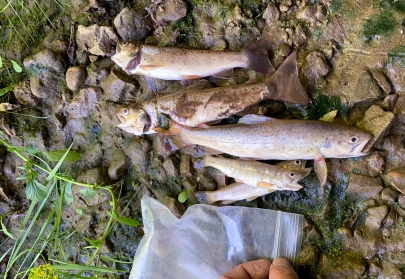Public invited to comment on draft guidance

The Minnesota Pollution Control Agency (MPCA) today released a statewide, multi-agency protocol that clearly shows how agencies work together when investigating fish kills in Minnesota. The new guidance includes investigation process, communications expectations, and strategies for reducing fish kills. The MPCA seeks public comment on this draft protocol.
“Our goal is to respond quickly and efficiently to gather evidence of what may have contributed to fish kills,” said Glenn Skuta, director of MPCA’s Watershed Division. “Better coordinating our response with the departments of Agriculture, Health, and Natural Resources will help us do that. Fully investigating these events will offer ways to prevent incidents in the future.”
In 2023, the Minnesota Legislature passed a law mandating the development of a fish kill response protocol. A fish kill is the unexpected, sudden death of large numbers of fish in a certain area. The fish kills addressed in the new protocol include those related to the discharge or runoff of pollutants from the land through incidents like toxic spills; runoff of manure, pesticides, or fertilizers; and high-temperature wastewater or stormwater discharges.
The MPCA collaborated with Minnesota Department of Agriculture (MDA), Department of Natural Resources (DNR), and the Minnesota Department of Health (MDH) to develop the draft protocol. The protocol lays out what happens when a fish kill occurs and how best to unify response and staffing to minimize damage and exposure. It includes:
- Clear explanation of roles and responsibilities.
- The MDA leads a fish kill response for pesticide and fertilizer incidents.
- The MPCA leads a fish kill when there are environmental impacts from the release of hazardous substances.
- The DNR serves as a support when a pollutant discharge/release causes injury to fish, wildlife, waterways, and/or public lands and often leads investigation of non-urgent fish die-offs.
- In cases when an urgent fish kill presents a threat to public health and safety, agencies will coordinate with MDH. If there are concerns regarding impacts to drinking water or fish consumption, MDH may test nearby wells and notify landowners of threats to drinking water.
- Definition for “urgent” and “non-urgent” fish kills.
- Urgent fish kills are related to pollution or a spill, have a high impact, and are recent and ongoing. Urgent fish kill response is typically led by the MPCA or MDA.
- Non-urgent fish kills are winter or summer die-offs, linked to a disease or pathogen, and have low impact. Non-urgent events are typically led by the DNR.
The protocol also better describes the process of notifications and subsequent general communications required during an investigation and includes strategies that will prevent future fish kills. The agencies will review the protocol every five years.
The public comment period begins March 11 and ends May 10. Members of the public are invited to review the draft protocol and submit comments by visiting the public comment page or by U.S. mail to: Minnesota Pollution Control Agency c/o Justin Watkins, 7381 Airport View Drive, Rochester, MN 55902. Submit your comments by May 10, 2024.
Public meeting
The MPCA will host a virtual public meeting to review the details of the draft protocol on April 16 at 10 a.m. Visit the public meeting page to learn more.